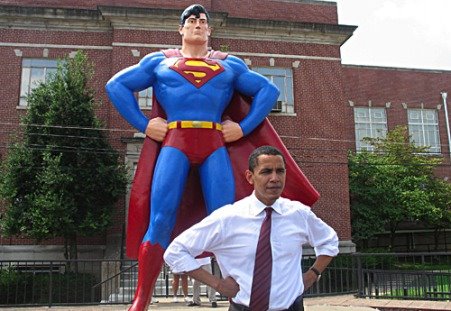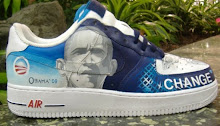
I found myself liking him a bit more at that moment, assuming he'd be a wily player, quick and catlike, fast to the hoop, his shot difficult to block.
Obama's interest in basketball has become an interest of the American public, and there has been a push to watch him play and to see him in action on the hardwood. Such images have many potential advantages but carry some drawbacks as well.
On the plus side, Basketball Obama comes off as sort of macho, a man's man, confident and athletic. You can imagine him bonding during pickup games, playing hard defense on his man, standing up for himself if he gets a hard foul in the lane. It also contrasts his youth and agility against John McCain's lack of either. Obama's lean, healthy athleticism makes McCain's aging, greying, and cancer-visited body seem profoundly not young.
We also like to see our president hanging with regular folk, and so photos of our politicians playing sports do this cultural work. Though his swing is atrocious, watching George W. Bush hit golf balls with other white guys somehow reassures us that at least something in his life resembles that of a normal guy. We think, therefore, because we see him be a bogey or double-bogey golfer, that he might see the world the way an average double-bogey golfer would. Most mediocre golfers love their families and like peace and don't want to send people into war or shift the tax burden to the middle class. We see that bad swing, and we think we're okay.
Such is the power of the sports image.
 On the downside are the negative connotations some tend to associate with basketball and black men. More than other major American sports, basketball has become dominated by African American players, and with the exception of Steve Nash and perhaps Pau Gasol, its superstars are all black. Golfing and jogging and hunting--the sporting domains of President Bush--could hardly be whiter. Conversely, if you ask most Americans what sport a black man is most likely to play, they will probably say basketball. The only problem with this is that Obama and his image handlers want him to appeal to white voters, white women, and poor whites, and those with negative opinions of African Americans may see in Obama's basketballness his blackness.
On the downside are the negative connotations some tend to associate with basketball and black men. More than other major American sports, basketball has become dominated by African American players, and with the exception of Steve Nash and perhaps Pau Gasol, its superstars are all black. Golfing and jogging and hunting--the sporting domains of President Bush--could hardly be whiter. Conversely, if you ask most Americans what sport a black man is most likely to play, they will probably say basketball. The only problem with this is that Obama and his image handlers want him to appeal to white voters, white women, and poor whites, and those with negative opinions of African Americans may see in Obama's basketballness his blackness.One has to hope that America's semiotic sophistication goes beyond stereotype, beyond the "image" of basketball players, black politicians, and black athletes.
What people who see Obama play basketball should consider is that basketball teaches teamwork, collaboration, patience, behind the scenes work, and both offense and defense. There is no quarterback, no goalie, no pitcher, no designated hitter--it is America's most democratic game. It's the great equalizer. It is the anti-golf.
--D. R.





















